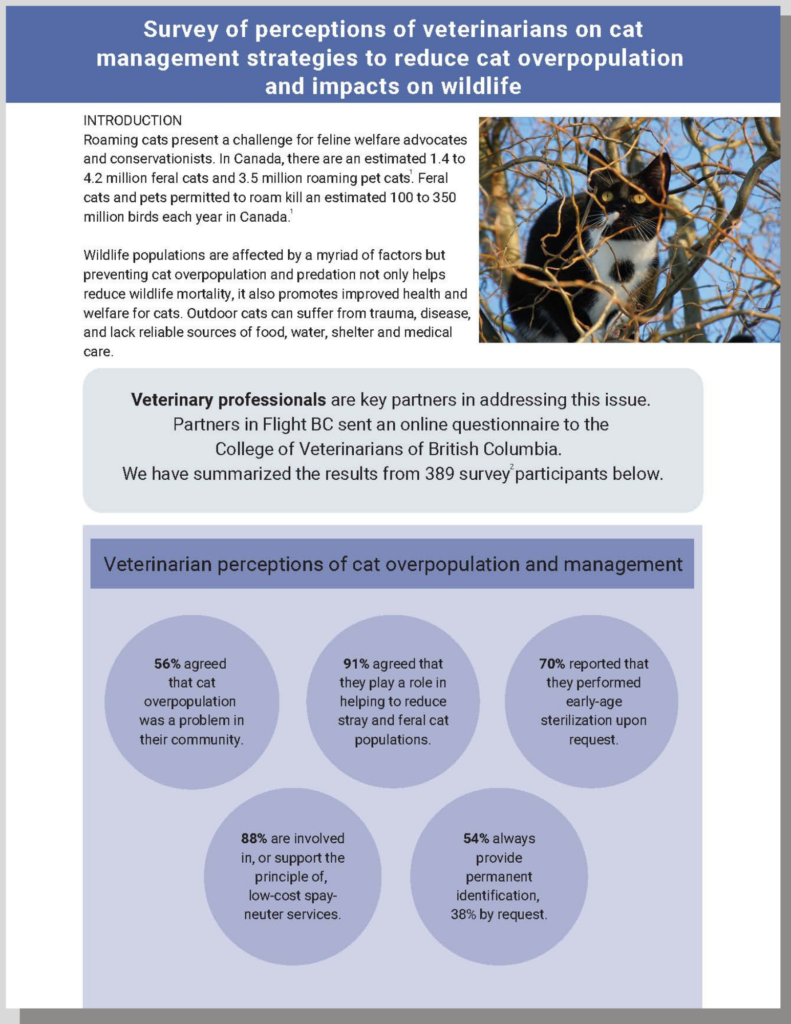Cats and Birds | For Veterinarians
Veterinarians play an important role in the Cats and Birds issue
New cat owners and returning clients will always rely on their veterinarians as a source of the most reliable information. Pet owners trust their veterinarians and are more likely to listen to their advice. Thus, veterinarians and vet technicians who directly interact with cat owners, have a perfect opportunity to educate their clients about responsible cat ownership and advise on keeping cats indoors with proper physical and mental stimulation practices recommended.

Results of a survey of perceptions of veterinarians on cat management strategies to reduce cat overpopulation and impacts on wildlife
New cat owners can be provided with the Happy Cat Brochure to help them adopt the best practices for cats.
New CVMA’s position statement supports the One Health approach
The Canadian Veterinary Medical Association (CVMA) supports evidence-based, effective and humane initiatives to reduce the population size and the impacts of free-roaming owned, abandoned and feral cats in order to promote animal health and welfare, public health and ecological and environmental health.

The CVMA recommends that veterinarians discourage the unsupervised roaming of owned cats due to the health and welfare risks to individual cats, their potential contribution to the stray and feral populations, impacts on wildlife populations, and increased zoonotic public health risk.
Click to access CVMA’s Free-roaming owned, abandoned, and feral cats – position statement
Veterinary education about cat impacts on wildlife
With support from Environment and Climate Change Canada, in 2019 Stewardship Centre for BC began working with five Canadian veterinary colleges, five veterinary technology programs and a continuing education program for veterinarians to deliver seminars about the role of veterinary professionals in cat and wildlife welfare.
As part of this project, Stewardship Centre for BC works to find opportunities to incorporate information about free-roaming cat welfare, cat overpopulation issues and the impact of roaming cats on wildlife into the veterinary curriculum.
Below is one of the presentations recorded for veterinary technologists about the role they play in reducing risks to cats and wildlife through education and outreach with current and future clients.
Presentation for veterinary technologists about the role they play in cat and wildlife welfare. Presented by Kirstina Burns, Professor, Veterinary Technician and Veterinary Assistant Program, Georgian College. This presentation was supported by the Stewardship Centre for BC and Environment and Climate Change Canada.
Participating veterinary schools and veterinary technician programs
Since 2019, the following veterinary schools and veterinary technician programs took part in this project and hosted a Cats and Birds lecture for their students. Some of those institutions have incorporated the Cats and Birds content into their curriculum to continue educations about the issue of roaming cat welfare and the impact of roaming cats on people and ecosystems. We gratefully acknowledge the schools and professors who showed interest in the Cats and Birds topic:
- University of Calgary – Faculty of Veterinary Medicine
- University of Saskatchewan – Western College of Veterinary Medicine
- University of Guelph – Ontario Veterinary College
- University of Guelph – Veterinary Technology Program, Ridgetown
- University of Montréal – Faculty of Veterinary Medicine
- University of Prince Edward Island – Atlantic Veterinary College
- Saskatchewan Polytechnic – Veterinary Technology Program
- Thompson Rivers University – Animal Health Technology Program
- Dalhousie University – Veterinary Technology Program
- Georgian College – Veterinary Technology and Vet Assistant Program
- Calgary Academy of Veterinary Medicine – Continuing Education
If you are a Professor or a Program Coordinator of the veterinary education program at a Canadian institution and are interested in expanding your curriculum to include information about roaming cats’ impact on wildlife and applicable science-based solutions to cat overpopulation and predation, please contact us at info@stewardshipcentrebc.ca.
Learn more about the Cats and Birds presentation for veterinary students and professionals:
If you are a Professor or a Program Coordinator of the veterinary education program at a Canadian institution and are interested in expanding your curriculum to include information about roaming cats’ impact on wildlife and applicable science-based solutions to cat overpopulation and predation, please contact us at info@stewardshipcentrebc.ca. Learn more about the Cats and Birds presentation for veterinary students and professionals here.
For more information about the role of veterinarians in the Cats and Birds issue and resources for their clients, please visit our Cats and Birds Resources page.




